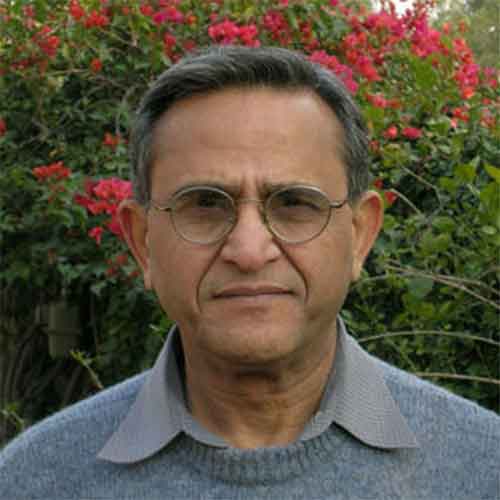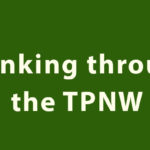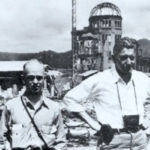We interviewed a prominent Pakistani physicist and noted peace activist Dr. Abdul Hammeed Nayyar to understand the dynamics of nuclear disarmament between India and Pakistan. Dr. Nayyar taught nuclear physics at Qaid – E- Azam University, Islamabad for thirty years and was a visiting scholar at Princeton University. Dr Nayyar is well known for voicing for education reforms and military arms control.

Q) Can you tell us about your work on nuclear disarmament and MND : Movement for Nuclear Disarmament in Pakistan ?
We were a group of university professors who in 1985, started educating people about horrors of nuclear weapons. We started around 1985, much before Pakistan’s nuclear programme became any serious. We reached out to prominent people in media & civil society and received a very good response from all of them. We wrote many papers on disarmament which were published. Some of us were invited by the Pakistan Military to discuss strategic matters.
Many colleagues from India also supported our movement on Pakistan India Forum for Peace and Democracy, which started in 1994. We were joined by many powerful activists and journalists like Prafful Kidwai and Sandeep Pandey.
Just as there were reports that India and Pakistan were beginning to make progress on disarmament, there were a few crises. Most prominent was in 1987 : Operation Brass Tacks conducted by Indian Military in the Thar desert. The exercise led by Gen. Sundarji was massive and Pakistan got scared. Gen Sundarji had talked about this doctrine where Indian forces will do a blitzkrieg and completely cripple Pakistan by dividing it in two parts. Pakistan got very paranoid and there were reports that Pakistan started mobilizing whatever nuclear weapons they had.
Reports had already come out that Pakistan had done cold tests of nuclear weapons in 1985 and they were ready. Americans had alerted Indians about the possibility of nuclear escalation in case of conventional war. The situation was ultimately diffused by American Diplomats. But this was the time when we started educating people about the grave danger in which we were living in. There were frequent missile tests and escalations between India and Pakistan.
Then came the 1998 nuclear explosions. We had been warning people that it would happen. Nuclear establishments want to be rewarded for their work and acknowledged as national heroes. So they have a very strong stake in getting tests done and are always pushing the political establishment. We had predicted that both the countries would conduct the tests, India exploded on 11 & 13 May and Pakistan exploded bombs a fortnight later on 28 May.
Q) What was the domestic reaction to your movement after both the countries tested their nukes in 1998 ?
Once India had exploded bombs, we wrote here that Pakistan should not join the nuclear race and should avoid the temptation to test. There was severe backlash against us. No one listened to us and we were treated as complete outcasts. Once Pakistan tested bombs, we wrote that what has been done was not good and India & Pakistan should sit together and aim for nuclear disarmament. There was so much euphoria in the country that no one was willing to listen to us. In one of the press conferences, the press beat us up and attacked us. This was the reaction. There were continuous attacks against us and efforts to silence us. But gradually, the attacks petered out, probably they realized that no one was listening to us.
Our work continued through other forums, first there was Pakistan India Forum for Peace and Democracy and then Citizens Peace Committee, Asian Peace Alliance all aimed towards denuclearization.
Q) What are your views on the theory of Nuclear Deterrence ? There is viewpoint that Nuclearization can in fact insure peace between the countries ?
Theory of Deterrence has been debated in great detail by people and game theory experts. One argument is also that if you have nuclear weapons in your hand, you become more adventurous and try to test the red lines of your opponent. The Kargil War is a good example, Pakistani Army had always been looking for some sort of advantage in Kargil and Siachen. The idea was to have a limited conflict which did not give an excuse for nuclear retaliation.
If deterrence is to work, both the countries have to be absolutely convinced of mutually assured destruction. I remember an incident, when I K Gujral was the Prime Minister of India, he was talking to a Pakistani Diplomat(my friend). Gujral told him in no uncertain terms that he believed Pakistan’s nuclear program was a hoax and Indians do not believe it exists and are not worried about it. Soon after India exploded nukes, Indian politicians for example Advani & Fernades started challenging Pakistan in a very hostile way. They made statements that Pakistan had no option but to accept India’s superiority and the whole equation had changed. So, when you have these weapons you have extra confidence in yourself and you tend to act in an aggressive manner. If such hostile challenges were not made, Pakistan may not have tested nukes. There was a strong argument against testing : that UN sanctions would absolutely cripple Pakistan’s economy. But Pakistan was forced to explode just to keep Indians at bay.
So this is the danger with nuclear weapons, countries which are not mature enough like India and Pakistan engage in childish behaviour and that poses a grave danger. Deterrence worked between USA & USSR because both the countries were mature enough to realize that each one of them possessed ICBMs and nukes capable of destroying each other many times over.
Q) How did the equation between India & Pakistan change after the Kargil War ? How did it impact MND ?
They badly soured the relations between the two countries. Before Kargil, Vajpayee had visited Pakistan and said that he was hopeful that India and Pakistan would sort out their issues and there would be easing of relations. Then Kargil happened, 9/11 happened, Pakistan got involved in the war in Afghanistan and the attack on Indian Parliament happened. There was a huge inflow of Afghan refugees into Pakistan. These things took attention away from our activism. Our activism certainly became zero around that time. We still continue to write about disarmament.
Q) Can you tell us about No War Pact between India & Pakistan that you were alluding to ? Do you think it is relevant today ?
This is something me and Sandeep Pandey have worked together on. We proposed this around the time of the Agra Summit in 2002. The Agra summit failed. Our proposal stressed on the things that India and Pakistan could agree on. We thought it would reduce suspicions and tensions between the two countries. I think even in the present, it makes a lot of sense for both the countries to sign such a pact. It can reduce the rising militarism in both the countries. It can reduce the suspicions prevalent in both countries.
Both India and Pakistan have been hurting each other for decades whenever they can see a weakness. India did it in Bangladesh (East Pakistan) , Pakistan did it in Punjab. And both of them continue to throw this ball of no war pact to each other whenever it suits them.
What we need is, to broadly define acts of war. It should not be just limited to full fledged war between the armies. It should include things like use of non state actors for terrorism, blocking of river waters etcetra. Then we can have arbitrators for example South Asian countries like SriLanka, Bangladesh, Nepal , Bhutan to decide if there has been a violation of the No War Pact. Personally I see a lot of reasons to push for it now.
(About Author : Vikas Kumar is a Management Student at IIM Ahmedabad and is working for an India that will realize the cherished constitutional values of Justice, Liberty and Fraternity) (Interview by : Vikas Kumar, Shreshth Virmani, Raghav Gupta)


